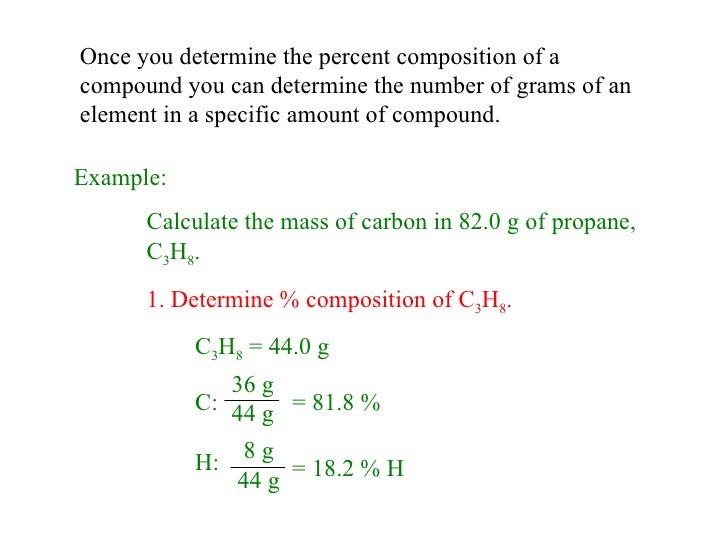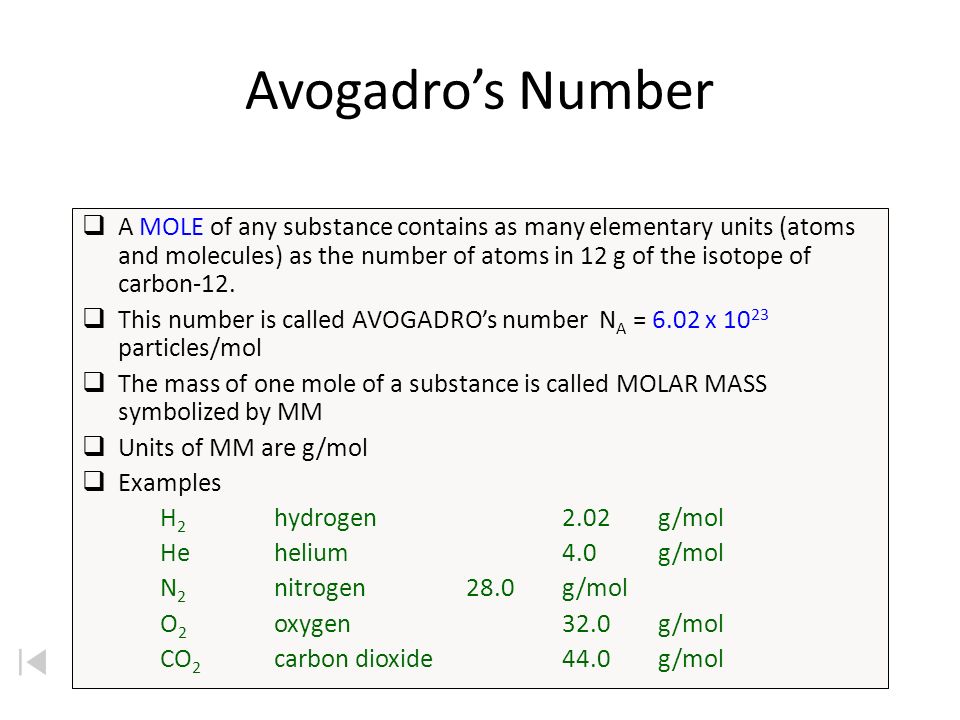- Why Is A Mole 6.022 X10 23
- Avogadro's Number And Mole Concepts
- Avogadro's Number And Mole Concept Worksheet
- Avogadro's Number And Mole Concept Analysis
- Avogadro's Number And Mole Concept Map
Molecules and atoms are extremely small objects - both in size and mass. Consequently, working with them in the laboratory requires a large collection of them. How large does this collection need to be? A standard needs to be introduced. This standard is the 'mole'. The mole is based upon the carbon-12 isotope. We ask the following question: How many carbon-12 atoms are needed to have a mass of exactly 12 g. That number is NA - Avogadro's number. Thus, NA is defined by Careful measurements yield a value for NA = 6.0221367x10^+23. This is an incredibly large number - almost a trillion trillion. For example, if we stack NA pennies on top of one another how tall would the stack be? The answer is it would be so tall that the stack of pennies could reach the sun and back almost 500 million times! A convenient name is given when there is an Avogadro's number of objects - it is called a 'mole'. Thus in the above example there was a mole of pennies. The mole concept is no more complicated than the more familiar concept of a dozen : 1 dozen = 12 objects. From the penny example above one might suspect that the mass of a mole of objects is huge. Well, that is true if we're considering a mole of pennies, however a mole of atoms or molecules is a different story. Recall that the atomic mass unit (amu) is defined as 1/12 the mass of a carbon-12 atom. Consequently we have the relation Thus, a mole of carbon-12 atoms has a mass of just 12 g. What about other atoms? In the periodic table the atomic mass of the elements is given. For example the atomic mass of magnesium is 24.305 amu. This is the average isotopic mass of naturally occurring magnesium. What is the molar mass of magnesium in grams? From the equation above we get 1 amu = 1g/NA or 1 amu = 1.66054x10^-24 g. Thus, a mole of magnesium atoms has a mass of NA x 24.305 amu x (1.66054x10^-24 g/amu) = 24.305 g. A mole of magnesium atoms has a mass of 24.305 g. This example demonstrates that the atomic mass of magnesium can be interpreted in one of two ways: (1) the average mass of a single magnesium atom is 24.305 amu or (2) the average mass of a mole of magnesium atoms is 24.305 g; A similar conclusion follows for all of the other elements. |
Back to index
Aug 25, 2020 The mole is defined as the amount of substance that contains the number of carbon atoms in exactly 12 g of carbon-12, Avogadro’s number (6.022 × 10 23) of atoms of carbon-12. One mole of a substance is equal to 6.022 × 10²³ units of that substance (such as atoms, molecules, or ions). The number 6.022 × 10²³ is known as Avogadro's number or Avogadro's constant. The concept of the mole can be used to convert between mass and number of particles. Created by Sal Khan.

Why Is A Mole 6.022 X10 23
Stoichiometry
source: Pinterest.com
Stoichiometry Numericals-
Question 1-
How many moles & atoms are in the following-
(i) 14.01 gm N (ii) 80.16 gm Ca (iii) 76.41 Vanadium
Solution-
(i) 14.01 gm N
mass of N = 14.01 gm,molar mass of N = 14.01 gm/mole
moles = mass / molar mass
= 14.01 / 14.01
mole of N = 1 mole
1 mole of N has = 6.023x 1023 atoms
no. of N atoms = 6.023x 1023
(ii) 80.16 gm Ca
mass of Ca = 80.16 gm,molar mass of Ca = 40.08 gm/mole
moles = mass / molar mass

= 80.16/ 40.08

mole of Ca = 2 mole

1 mole of Ca has = 6.023x 1023 atoms (avogadro’s no.)
2 mole of Ca has = 2 x 6.023x 1023 atoms
no. of Ca atoms = 12.046 x 1023
(iii) 76.41 gm Vanadium
mass of V = 76.41 gm,molar mass of V = 50.94 gm/mole
moles = mass / molar mass
=76.41 / 50.94
mole of V = 1.5 mole
1 mole of V has = 6.023x 1023 atoms (avogadro’s no.)
1.5 mole of V has = 1.5 x 6.023x 1023 atoms
no. of V atoms = 9.0345 x 1023
Question 2- How many Mg+2 ions are found in 1.00 mole of MgO ?
Ans-
1.0 mole MgO = 1.0 mole Mg+2
Therefore,
moles of Mg+2 = 1.0
we know,
Avogadro's Number And Mole Concepts
1.0 mole Mg+2= Avogadro’s number
No. of Mg+2in 1.0 mole MgO = 6.022 x 10 23 Mg+2 ions
Stoichiometry Numericals-
Question 3- How many grams of Al can be created by decomposition of 9.8 gm of Al2O3 ?
Solution –
2Al2O3 —> 4Al + 3O2
2 mole 4 mole 3 mole
mass of Al2O3 = 9.8 gm
molar mass of Al2O3= 102 gm/mole
moles of Al2O3 = mass / molar mass
= 9.8 / 102
moles of Al2O3 = 0.0961
2 moles Al2O3 gives = 4 mole Al
0.0961 moles Al2O3 gives = 4 x 0.0961 / 2 = 0.1922 mole Al
moles of Al = 0.1922
molar mass of Al = 27 gm /mole
mass of Al = moles x molar mass = 0.1922 x 27 = 5.1894
Mass of Al = 5.19 gm
Question 4-
0.5 L of 0.20 M HCl solution is mixed with 0.5L of 0.40M AgNO3 solution & reaction occurs.If the reaction goes to completion ,what mass of AgCl produces ?
Ans-
HCl + AgNO3 —> AgCl + HNO3
Molarity of HCl = 0.20M
Avogadro's Number And Mole Concept Worksheet
Volume of HCl = 0.5L
moles of HCl = Molarity x volume(L)
= 0.20 x 0.5
moles of HCl = 0.1
Molarity of AgNO3= 0.40M
Volume of AgNO3 = 0.5L
moles of AgNO3 = Molarity x volume(L)

= 0.40 x 0.5
moles of AgNO3 = 0.2
1mole HCl reacts with= 1 mole AgNO3
0.1mole HCl reacts with= 0.1 mole AgNO3
Avogadro's Number And Mole Concept Analysis
But 0.2 mole AgNO3 are present ,so HCl is limiting reagent.
0.1 mole HCl gives 0.1 mole AgCl.
Avogadro's Number And Mole Concept Map
molar mass of AgCl = 143.32 gm/mole
mass of AgCl = mole x molar mass = 0.1 x 143.32 = 14.332 gm
Mass of AgCl = 14.332 gm
